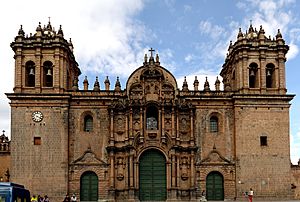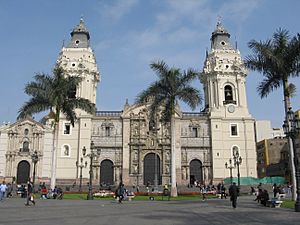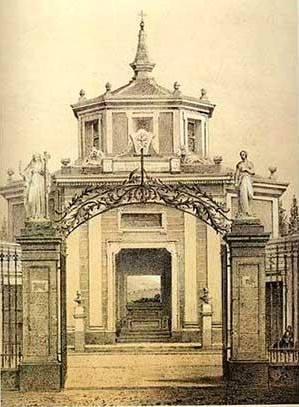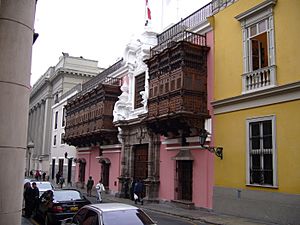Peruvian colonial architecture facts for kids

Peruvian colonial architecture is the amazing building style that grew in Peru when it was a Spanish colony, from the 1500s to the 1800s. This period was called the Viceroyalty of Peru. During this time, European building styles came to Peru. But they didn't just copy them! Builders in Peru mixed these styles with local Peruvian ideas. This created a truly unique type of architecture.
At first, some people thought that Spanish building styles completely took over. However, we now know that local Peruvian people and their traditions played a big part. They used special building methods, like quincha (a type of adobe). They also added Andean art and symbols to the buildings. This blend gave Peruvian colonial architecture its own special look.
Contents
Renaissance Style: Early Peruvian Designs

In the early days of the Spanish colony, the Renaissance style became popular. This style came from Europe, especially from Italy. It was known for its detailed decorations. Imagine buildings looking like finely carved silver! This is why it was often called plateresque, which means "silversmith-like."
This style often mixed ideas from Gothic, Romanesque, and Arabic designs. It was popular from the 1500s to the mid-1600s. Great examples in Lima include the front of the Cathedral of Lima. In Ayacucho, you can see it on the churches of San Francisco and La Merced.
Baroque Style: Bold and Ornate Buildings
The Baroque style was very different. It was known for being super decorated and having lots of curves. Buildings looked like they were moving! You would see many fancy decorations on columns, walls, and ledges.
Classical Greek columns changed in this style. They often twisted like thick snakes, creating what are called Solomonic columns. The decorations became very rich and detailed. A special feature of this style is rustication. This means the stone blocks on walls look rough or unfinished, like on the Monastery of San Francisco, Lima.
Baroque was popular from the mid-1600s to the late 1700s. Later, it led to even fancier styles like Churrigueresque and Rococo. In Lima, you can see Baroque in the Torre Tagle Palace and the churches of San Francisco and San Marcelo. In Cuzco, the Cathedral of Cuzco is a great example of Andean Baroque. The churches of Santo Domingo and San Sebastián also show this style. In Arequipa, check out the Church of La Compañía.
Andean Baroque: A Unique Peruvian Mix
During the late 1600s and 1700s, a new style grew in southern Peru and Bolivia. This was the Andean Baroque. It mixed European Baroque with local Inca and Aymara art. You might see native flowers like the kantuta or symbols like the Inka maskaypacha crown. Local animals and plants, like Arequipa papayas, were also carved into buildings.
Indigenous sculptors often created this style. They sometimes got ideas from local textile patterns. This new style mostly appeared on the stone fronts of churches and palaces. It started in Arequipa and then spread to the Lake Titicaca area and further south. It was one of the most exciting mixes of styles in all of colonial Latin America. Important buildings include the Church of La Compañía and Puno Cathedral.
Churrigueresque Baroque: Extra Fancy Designs
This was the most decorated type of Baroque style. It used very complex and unusual decorations. A Spanish architect named José de Churriguera was a big fan of this style. In Lima, you can see amazing examples on the fronts of the churches of Nuestra Señora de la Merced and San Agustín.
Rococo: Lighter and More Elegant
- See also Rococo.
In the 1700s, the Rococo style arrived from France. It was a bit lighter and less heavy than Baroque. Rococo buildings often had balconies that were not rounded. The decorations on columns were also simpler and less twisted. While Baroque loved curves, Rococo still used them but with more grace.
Examples of Rococo in Lima include the Quinta de Presa, the Casa de Larriva, the Trece Monedas House, the Osambela House, and the Paseo de Aguas.
Neoclassical Style: Back to Basics

In the late 1700s and early 1800s, the Neoclassical style appeared. This style was a reaction against the super ornate Baroque. It aimed to go back to the simple, classic styles of ancient Greek and Roman buildings.
Neoclassical buildings often used straight lines and simple designs. You would see Roman-style columns with Corinthian capitals, but without too many decorations. They also often had triangular front sections, like ancient temples.
Great examples of this style include the altar and towers of the Cathedral of Lima. The front of the Basilica and Convent of San Pedro and the main altar of the Basilica and Convent of San Francisco also show Neoclassical features. You can also see it in the columns of the Osambela House, the front of Fort Santa Catalina, and the Presbyter Matías Maestro Cemetery.
See also
 In Spanish: Arquitectura virreinal peruana para niños
In Spanish: Arquitectura virreinal peruana para niños
- Architecture of Peru
- Balconies of Lima
- List of architectural styles


